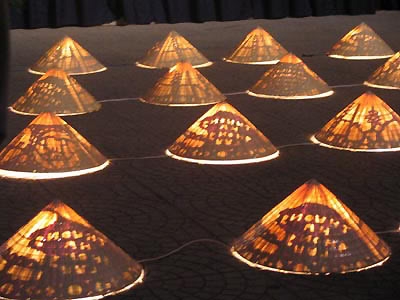If you are lucky enough to arrive at Chuong village on market day, you will happen upon a wonderful scene, the village`s market ground covered with thousands of conical palm hats, known in Vietnamese as non.
On days that end with zero and four in the lunar calendar, merchants from many provinces gather here to buy stacks of Non, which they then distribute throughout the North of Vietnam.
This small village of Ha Tay Province, 40 kilometres on the west of Hanoi, has maintained its reputation for over three centuries. Just like Van Phuc villagers with their fine silks, Cu Da villagers with their soy sauce, Chuong people have their own pride for the famous Non.
If you look at a hat, it seems that it is easily to make. It is wrong! To make a proper hat it is not only required the maker`s talent but also their experience. Bamboo cataphyll must be split into very thin strings during the dry season. They then must be quickly submerged in water to preclude tearing and breaking. Main rings (the largest) must be even, smooth and shiny. The most sophisticated work is treading the palm material. The makers buy dark green palms, then clean them by sand and work them with a light touch or otherwhile they will tear. After the step of treading the palms, they sun-season them. The palm will go from dark green to white. The stronger the sun the whiter the palms will become. Before using the palms, makers expose them briefly to sulfur to make them whiter and to preserve the color. Finally, before using them, they are exposed to frost to make them soft, then they are split and ironed. From the palms and ring, using silk thread, you only to have to sew it together. It is easy to say than to do. Sewing and decorating are very sophisticated too. You have to sew small and even stitches what mean you need time and have to be very patience. For professional purposes, Chuong hat-makers do not accomplish all the stages but specialize - building upon a frame made somewhere else. The local hat-makers complete the hats with an aesthetic appeal suitable to customer`s taste.
Chuong hats are different from hats of other provinces which are revolved only two times, with the second being in a reverse direction, Chuong village`s hats are revolved three times, two times with white palm and once with bamboo cataphyll. Thank to the addition layer of bamboo cataphyll, Chuong hats are more solid and durable. Show them what revolve mean.
Since the first images of Non were etched into Ngoc Lu bronzes drums 3000 years ago, it has become an inseparable multi-purpose item for Vietnamese women. It is used as a shield to protect them from sun and rain, a glass to get water when they are thirsty, a fan when they are hot, and a basket when they have nothing else with them to carry things.
Due to its popularity, each region in Vietnam has, for itself, a well-known non-making village. The non of the Tay ethnic group has a distinctive red colour, while Non in Thanh Hoa differs from others with its 20-hem frame. Hue`s Non is thin and elegant, in contrast with the thickness of those from Binh Dinh.
Chuong artisans make two types of Non: the traditional flat-top, known as Non quai thao, and the cone-shaped Xuan Kieu that appeared in the 1930`s.
Women in the village learn to make Non since as teenagers. Anywhere and anytime, you can find them wrapped up in their work, stitching the white palm leaves.
"Non making is work of painstaking precision", said 83 year-old Le Thi Viet, the oldest master of Chuong village.
Palm leaves, the raw material of Non are bought from Thanh Hoa and Quang Binh in the Central region, or Phu Tho and Son La in the North. After being sun dried, the leaves are flattened by hand, and then ironed with a hot ploughshare until they turn absolutely white.
The skeleton of Non is formed by round bamboo hems. A Chuong village Non always has 16 hems, to make it firm and easily identified among others.
It is said by another 90 year-old artisan that in the past Chuong village produced three types of the hats; Non ba tam, Non nho and Non dau. The classic Non was large and flat, with a small hummock in the centre that fits the head.
Vietnamese women used to wear the traditional three-tailed or seven-tailed dress. The tails come in various tints: they may have the colour of a peach blossom, a day-lily flower, a Tonkin bunch, or a lemon.
In the old days, Non quai thao were sported with a pair of buffalo-leather bow shoes or painted wooden clogs. A light pink or yellow belt makes a perfect match during festivals.
In the late half of 20th century, the flat-top hat was gradually replaced by the cone-shape, just as change has affected the basic ingredient; the palm leave. A new material, lui leaves from Nghe Tinh and Quang Binh province, make each Non Chuong lighter, and therefore more elegant.
Non are no longer built from the ground up by the tinkers of Chuong village. The process is divided into several phases, and the less important parts, such as skeletons and edges, are now farmed out to nearby villages. Todays Chuong artisans only undertake the roofing and sewing.
Such specialisation, however, may be a little misplaced, as women of modern times find Non less than practical for day to day life in the urban environment.
But the little girls of Chuong village are still sewing Non, and the hearth of the Non will always be warm.






































































































